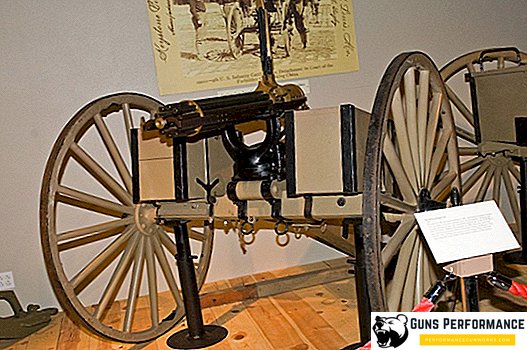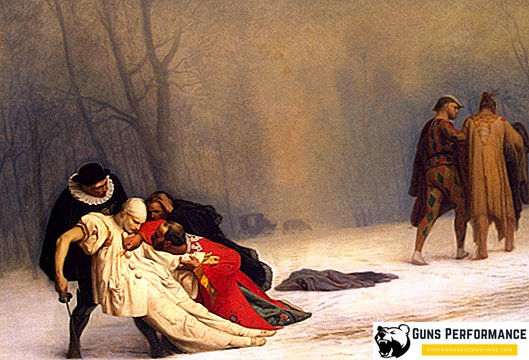
Man is an irrational being. In the animal world, everything is aimed at preserving the life of an individual and the continuation of its species. Self-preservation instinct is a powerful program that controls the behavior of any living creature. And only a man, despite his animal origin, is capable of actions, sometimes directly contradicting survival strategies. Often for the sake of abstract goals and very vague ideas, he is ready to put his health and life itself at stake. The history of mankind is replete with examples of such "illogical" behavior.
In the XV century, among the European nobility, a new custom emerged - dueling fights, the purpose of which was to protect the honor and dignity of one of the parties. Very quickly the duel turned into a way to resolve any conflict among the noble class. The history of duels began in Italy, but quickly spread throughout Europe and the continent was overwhelmed by a real "duel fever" that raged for several centuries and claimed the lives of hundreds of thousands of people. Only in France and only during the reign of Henry IV of Bourbon (about twenty years) between six and ten thousand young nobles died in duels. This is quite comparable with losses in a major battle.
Resolving conflicts with physical power is, in fact, as old as the world. It often happened that during such a search for consensus, one of the parties was sent to a better world. However, the duel was different from the usual fight tough rules, which were special dueling codes.

The European nobility, formed on the basis of medieval knighthood, had its own ideas of personal honor. Any encroachment on her in the form of an insult with a word or an action could only be washed off with the blood of the offender, otherwise the person was considered dishonored. Therefore, calls to a duel in the old days, as a rule, ended in death or injury to one of the opponents.
In reality, the reason for the duel could be anything, because the fact of causing an insult and its severity was interpreted by the “victim” himself. Yes, and the concept of "noble honor" was understood very widely. Anything could lead to the challenge: from revenge for a murdered relative or friend to an unsuccessful joke or an awkward gesture.
Over time, fights became fashionable. Everybody fought in duels. Not only nobles, but burghers, soldiers, students and even crowned heads. The German Emperor Charles V challenged the French King Francis I to a duel, and the Swedish king Gustav IV sent a challenge to Napoleon Bonaparte. The French king Henry II died as a result of a duel, and the Russian emperor Paul I offered to abolish wars and resolve conflicts between states by holding fights between their rulers. However, such a bold idea did not find a response.
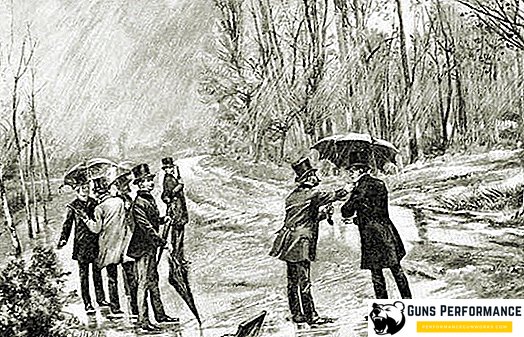
The duels tried to prohibit many times, and the brets were threatened with heavy fines, jail and even excommunication from the church, but there was little use of these measures. Fights continued until the beginning of the First World War.
In our country, duels have a special account. In the XIX century, their victims were two of the greatest Russian poet: Alexander Pushkin and Mikhail Lermontov.
Duel history
The name "duel" comes from the Latin word duellum, which meant a judicial duel. Although, it should be noted that the duels were just non-judicial and illegal fights. The place of the duel was usually carefully concealed.
Many researchers emphasize the resemblance of duels with judicial battles of the Middle Ages and knightly tournaments, however, despite some similarity, we are still talking about different things. Judicial fights were an integral part of the official justice system, and tournaments can be called a way to improve the skills of a professional warrior.
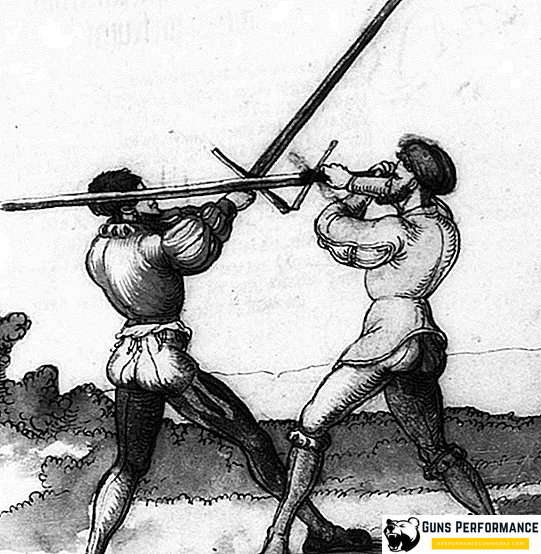
The judicial duel was called the “judgment of God,” and by no means was it a massacre, but rather a solemn ceremony. It was often resorted to when it was impossible to establish the truth in another way. It was believed that in this fight the Lord would help the right and punish the criminal. Moreover, such fights did not necessarily end with the death of one of the participants. Authorization to conduct court fights often gave the king himself. However, in the late Middle Ages, attitudes toward such fights began to change. In 1358, a certain Jacques Legre in the presence of the French king Charles VI lost a court battle, was found guilty and hanged. And soon they found the real criminal. It turned out a big scandal, after which the custom of court fights has sunk into oblivion. The church was very critical of this practice.
A duel in the form in which we know it, this is not the brainchild of the Middle Ages, but of the Renaissance. The only thing that probably connects court fights with duels is the idea of “God's judgment,” which was that the Lord would help the right and protect justice.
The duel was invented by the Italians around the XIV century. At this time they were what is called "ahead of the rest." A new age man was born in Italy, with other ideas about honor and ways to protect it. It was the Italian nobles and citizens who had the custom of resolving conflicts through armed combat. Here also appeared the first treatises with the rules of duels, they even described the degree of resentment, which must be followed by a challenge.
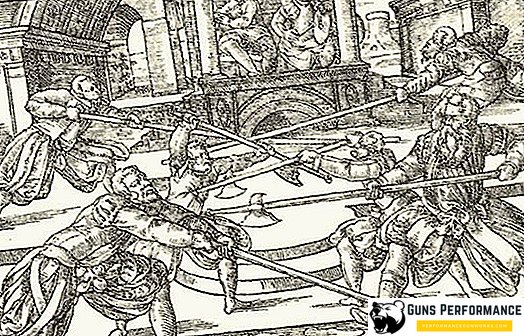
At the same time, a lighter sword is replacing the heavy swords of the Middle Ages, and then the weapon, which the Spaniards called the espada ropera, the “sword for clothing” —intended for permanent wearing with a civilian costume.
The place of the duel was usually chosen somewhere outside the city, such fights were fought with a minimum of unnecessary conventions, as tough as possible, therefore they often ended with the murder of one of the participants. Such fights were called "fights in the bushes" or "fight in the bushes." Their participants, as a rule, used the weapon that was with them, and usually were without armor, because very few people wore them in everyday life.
A distinctive feature of the fights of this era was that the rules of duels were very conditional and often did not fulfill them at all. Sometimes the seconds joined the fight, in which case it turned into a real bloodbath. In the case of a general fight, the fighter, having finished his opponent, did not hesitate to help his comrade. An example is the famous duel between the favorites of the French king Henry III and the duke de Guise, described in the Dumas novel The Countess de Monsoreau.
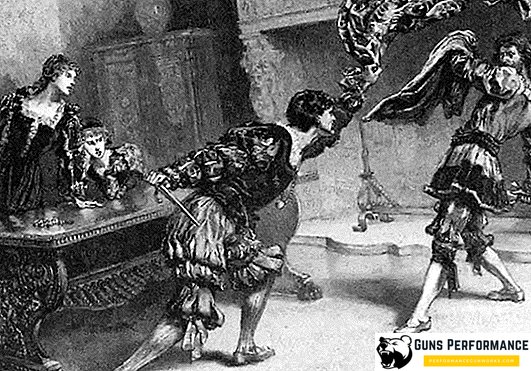
Moreover, the place of the duel was not regulated, there could be cobblestone pavement and wet grass. Therefore, the danger was no less than in real combat. The usual weapon of the duel of that time was a heavy sword or rapier and dagger (dagh). They could inflict not only stab, but also incised wounds. To repel the blows of the enemy, small dueling shields were used, or simply a cloak wound around the other hand.
Usually the caller chose the time and place of the duel, the weapon of the duel was determined by the one who was called. There were cases when fights were tied instantly and took place without any seconds at all. In the fight, it was possible to apply any methods: to distract the attention of the enemy, to finish off an unarmed, retreated or wounded, to beat in the back. Used and frankly vile techniques such as dressing hidden armor under clothing.
From Italy, the duels quickly spread to other European countries. They became especially popular in France during the period of religious wars and the Fronde. But, if in Italy the duels were usually kept secret and tried to fight without extra witnesses, the French nobles bleed each other, almost without hiding. It was considered an absolute “loss of face” to forgive the insult inflicted and not to cause one’s abuser to a duel, no less shame awaiting the one who refused to call.
It is believed that during the reign of Francis I in France, up to 20 thousand duels took place annually. It is clear that the account of the nobles killed in duels, also went to thousands. And it is not surprising that such a situation did not suit the supreme power of European states at all.
July 10, 1547 in France, the last official duel took place. Henry II forbade them after his favorite was killed in a duel. True, this did not change the situation at all, just now the duels were held underground. Not only the secular authorities, but also the church authorities, took up the fight against unnecessary bloodshed. At the Cathedral of Trent, it was announced that not only the participants or the seconds of the duel, but even its viewers, would automatically leave the church. The church in general was very intolerant of fights and actively fought with them until the end of the XIX century. Dead duelists, like suicides, were instructed not to bury them in cemeteries.
Henry IV equated dueling fights to insults His Majesty, Louis XIV issued 11 edicts against duels, and the famous Cardinal Richelieu actively fought against this phenomenon. The latter, as a punishment for a duel, introduced the death penalty or lifelong exile. In the Holy Roman Empire, fights were equated with deliberate murder with all the ensuing consequences.

Implacable opponents of dueling fights were Napoleon Bonaparte and Russian autocrat Nicholas I. The French emperor believed that "... the life of every citizen belongs to the fatherland; the duel is a bad soldier." Nicholas I considered the duel to be barbaric.
But even such draconian measures could not completely stop fights. Nobles considered the duel to be their legitimate privilege, and public opinion was entirely on their side. The tradition of fights was so respected that the courts often justified Breters.
Among the young nobles there were "professional duelists", on account of which there were dozens, or even hundreds of fights and the whole personal cemetery of the dead. Being high-class fencers, they constantly provoked quarrels, considering the duel the only way to achieve personal glory. The reason for the fight could have been anything: a side glance, an accidental collision, a misunderstood joke. The duel due to the cloak cut, described in The Three Musketeers, is an absolutely realistic situation for that time.
Initially, only cold weapons were used for fights, but in the 18th century duels with pistols appeared. It was a turning point. The winner of the duel with swords or rapiers was largely determined by the physical characteristics of the opponents, sometimes the outcome of the bout was predetermined in advance. The use of firearms greatly equalized the odds of the parties.
By the middle of the 18th century, the “duel fever” in Europe began to subside. Duels have become rare, and the rules for their conduct are more streamlined. Almost all steel fights are held with seconds, with a preliminary call. Swords duels, as a rule, were held before the first wound. All this led to a significant reduction in mortality among fighters. In the middle of the XVIII century, the French school of fencing reached its peak, the main weapon of duelists was a light sword, which could not be stabbed or cut.
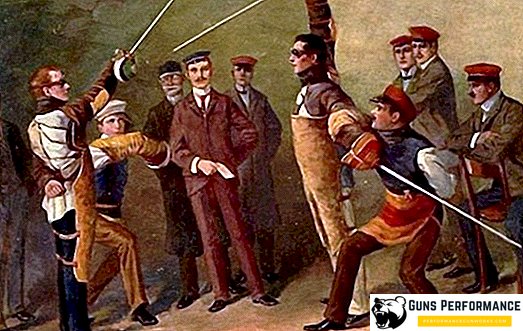
The development of the legal system and the growing awareness of the masses led to the fact that in the case of insult or insult, people went to court and did not grab hold of weapons. However, in the XIX century, duels were quite frequent, although they lost their former bloodthirstiness.
In 1836, the first duel code was published, the author was a Frenchman, Comte de Chateauville. In 1879, the code of Count Verger was published, it became more popular. In these two books, all the centuries-old experience of fights in Europe was summed up. In general, in the 19th century, the decline of the duel era began on the European continent. There were some "bursts", but in general they could not break the general trend.
Around the middle of the 19th century, an epidemic of “journalistic” duels began. A free press appeared in Europe, and now the heroes of their publications often challenged journalists.
Duels were held in the New World. They were very peculiar, and it was not the cowboy duel that is often shown in westerns. Opponents received weapons and went into the forest, where they began to hunt each other. A shot in the back or an ambush was considered the usual methods of an American duel.
Duel in Russia
The duel appeared in Russia much later than in the rest of Europe. The tradition of such fights in Russia did not exist at all. And this is not surprising, since before the reforms of Peter the Great, there was no European-type nobility - the main bearer of the idea of personal honor. Russian noblemen, officers and boyars of the pre-Peter the Great era did not see anything wrong in responding to an insult to complain to the tsar or seek justice in the courts.
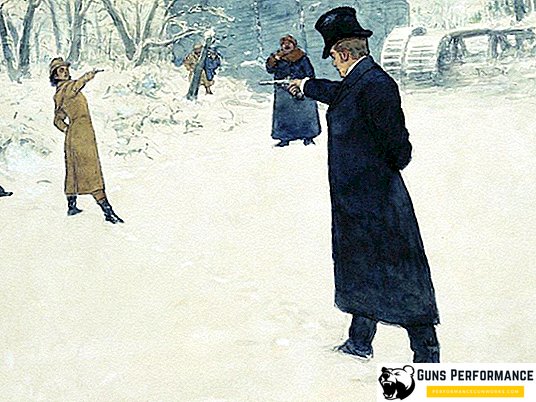
At a time when the dueling fever was fierce in Italy and France, in Russia everything was quiet and calm with respect to the fights, despite the fairly close ties with Europe that were already established during the reign of Alexei Mikhailovich. The first documented duel in Russia occurred in 1666, it was attended by two foreign officers who served in the "foreign" regiment. The outcome of this fight is unknown.
Emperor Peter I was the first to attend to dueling fights and issued a decree that forbade them under the penalty of the death penalty. Moreover, for participating in a duel, it was prescribed to hang not only the winner, but also the loser in it, even if at that time he was already in the grave: "... then hang them up after death". Krut was Peter Alekseevich, you will tell nothing.
However, dueling duels became a truly widespread phenomenon in Russia only during the reign of Catherine II. In 1787, the Empress issued a decree that regulated the punishments to participants in duels and their organizers. If the duel was bloodless, its participants - including the seconds - could only get away with large fines, but the instigator of the duel was waiting for Siberia. For injuries or death, the same punishment was prescribed as for ordinary criminal offenses.
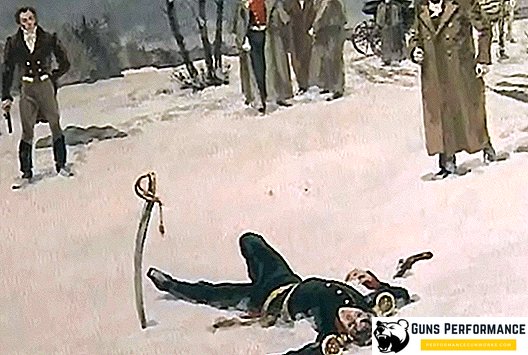
Despite the severity of these measures, they stopped little domestic duelists, because they were rarely performed. Duel cases rarely reached the court, and if that happened, the perpetrators, as a rule, received much milder punishments. As in Europe, public opinion was completely on the side of duelists.
In Russia, a kind of flourishing duel tradition came at the end of the XVIII - the first half of the XIX century. The situation can be called somewhat paradoxical: at a time when the “duel fever” in Europe has almost disappeared, the number of duels in Russia has increased significantly, and their cruelty has increased markedly. Some Western authors, noting the particular cruelty of the Russian duel, called it "legalized murder."
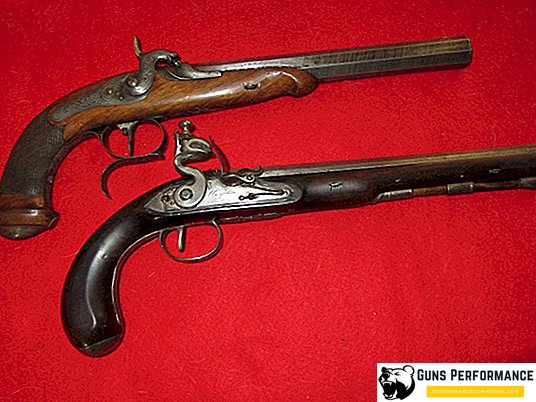
For example, usually shooting was carried out from a distance of 15-20 steps, from which it was extremely difficult to miss the mark (the Europeans fired from 25-30 steps). There was a practice according to which the enemy, shooting the second, could require his opponent to come close to the barrier. In this case, he got the opportunity to shoot an unarmed person from a minimum distance. In Russia, such duel methods were very popular, in which the duel inevitably ended in the death of one of the opponents (“through the handkerchief”, “blew into the barrel”, “American duel”). In Europe at that time, the blunder of both opponents usually ended the case, it was believed that in this case the honor of the participants was restored. In Russia, however, they often fired "to the result", that is, to the death of one of the duelists.
Russian duels of the first half of the XIX century left a noticeable mark in national history. The most famous of them, of course, are the fights of Pushkin with Dantes (1837) and Lermontov with Martynov (1841), in which two of the greatest Russian poets were killed. At the same time, their murderers did not become objects of public censure, the high society took their side. The official punishment was also very mild: Dantes was simply expelled from Russia, and Martynov got off with three months of a guardhouse and church repentance. This situation very clearly shows the attitude of the Russian society of that time to dueling fights.
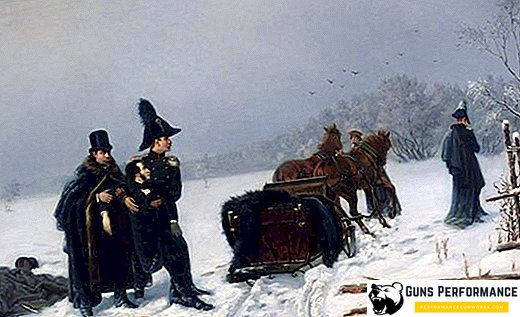
By the middle of the century, the number of duels in Russia began to noticeably decrease. However, in the reign of Alexander III fights were actually officially allowed. Moreover, in some cases for the officers they became mandatory. This decision led to a sharp increase in the number of duels in the army.
Fights continued until the beginning of World War I, but with the outbreak of hostilities, they were officially banned. The duel between Gumilyov and Voloshin, which took place in 1909, became one of the most famous duels of the 20th century. The reason for the duel was the poet Elizabeth Dmitrieva. The place for the fight was chosen very symbolic - not far from the Black River in St. Petersburg. Alexey Tolstoy became a second of literary men.
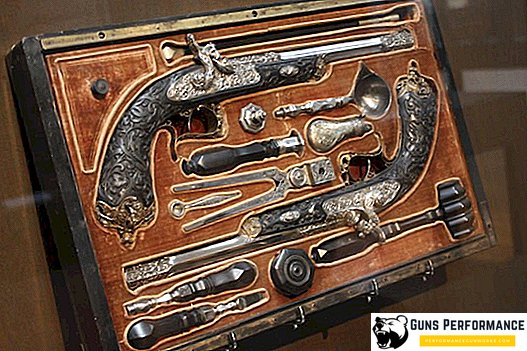
Fortunately, the duel was bloodless. Гумилев промахнулся, а пистолет Волошина два раза дал осечку.
Женские дуэли
Как вы представляете себе типичного бретера? Камзол, широкий плащ, лихой закрученный ус и широкополая шляпа? А как бы вы отреагировали на тот факт, что некоторые из дуэлянтов носили пышные юбки и были очень внимательны к укладке волос? Да, речь идет о женских дуэлях, которые, конечно же, случались реже мужских, но отнюдь не были чем-то из ряда вон выходящим.
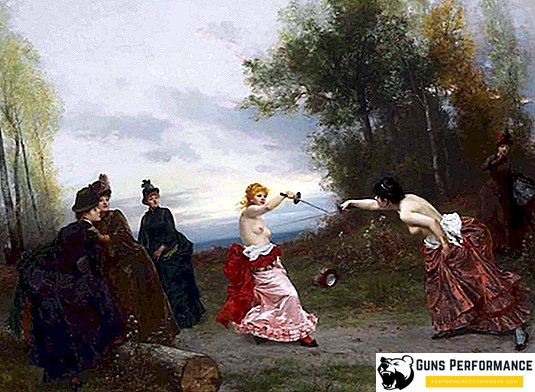
Одна из самых известных дуэлей между двумя женщинами состоялась в 1892 году в Лихтенштейне между графиней Кильмансегг и принцессой Паулиной Меттерних. Барышни не сошлись во взглядах по чрезвычайно важному вопросу: как лучше украсить зал для музыкального вечера. При этом присутствовала баронесса Любиньска - одна из первых женщин-докторов медицины. Именно она предложила соперницам драться топлес, но не для пущей пикантности (ее и так хватало), а чтобы не занести инфекцию в раны. Можно поспорить, но такое зрелище было куда круче современных женских боев. Правда, мужчин на женские дуэли не допускали, ни в качестве секундантов, ни, тем более, "чтобы посмотреть". А зря.
Вообще же тема полуобнаженной женской дуэли была весьма популярна у европейских художников XIX века, и их можно понять. Подобные сюжеты можно увидеть на картинах француза Жана Беро, а в миланском музее Прадо вы сможете можно полюбоваться полотном Хосе Риберы под названием "Женская дуэль".
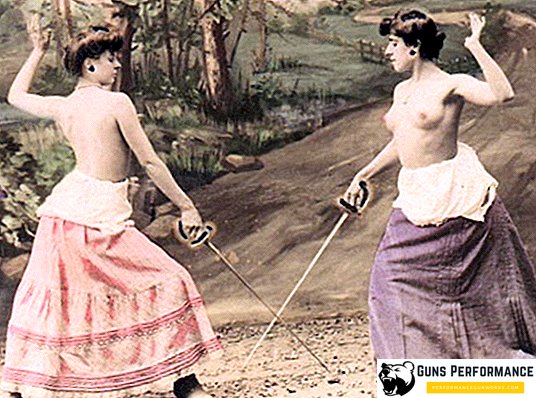
Тот поединок в Лихтенштейне закончился двумя легкими обоюдными ранениями: в нос и в ухо. Однако далеко не все женские дуэли заканчивались так безобидно.
Первый задокументированный поединок между представительницами прекрасного пола относится к 1572 году. Дело было так: две очаровательные сеньориты сняли комнату в женском монастыре святой Бенедикты, что около Милана, и закрылись к ней, объяснив монашкам, что им нужно срочно помолиться. Однако, оставшись наедине, дамы достали не молитвенники, а кинжалы. Когда дверь в комнату была взломана, в ней обнаружили страшную картину: одна из женщин была мертва, а вторая умирала, истекая кровью.
Своего пика женские дуэли достигли в XVII веке. Жительницы Франции, Италии и Испании словно бы сошли с ума. Поводом для разборок могло быть что угодно: косой взгляд, покрой платья, мужчина…
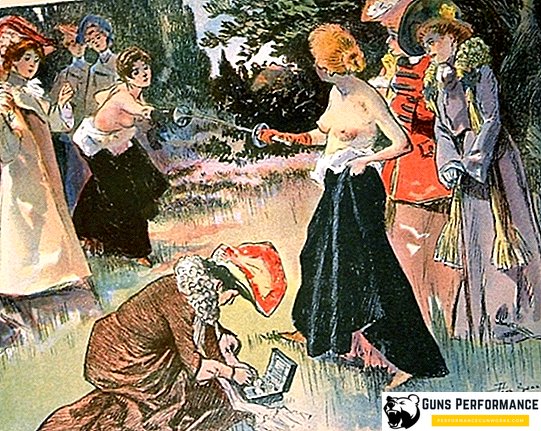
Причем поединки между женщинами были крайне жестоки. Если в дуэлях между мужчинами того времени одна смерть приходилась примерно на четыре поединка, то практически каждая женская дуэль приводила к появлению трупа. Характерно, что женщины практически не соблюдали правил во время дуэлей.
Во время женских поединков использовалось стандартное оружие: шпаги, рапиры, кинжалы, даги, реже пистолеты. От европеек не отставали и наши дамы, внося в эту потеху милый отечественный колорит: русские помещицы Заварова и Полесова рубились на саблях. Княгиня Дашкова отправилась в Лондон, где она не сошлась во взглядах в литературном споре с герцогиней Фоксон. Результатом ссоры стало проколотое плечо Дашковой. Ходили слухи, что даже будущая российская императрица Екатерина II в четырнадцатилетнем возрасте выясняла на дуэли отношения со своей троюродной сестрой. Учитывая темперамент Екатерины, данный факт не вызывает большого удивление.
Писательница Жорж Санд дралась с Марией д'Агу, выбрав в качестве оружия собственные ногти. В это время повод для поединка - композитор Ференц Лист - закрылся в комнате, чтобы не видеть всего этого безобразия.

Одной из самых известных дуэлянток, настоящим бретером в юбке, была мадам де Мопен - знаменитая оперная певица, блиставшая на сцене Гранд Опера. Счет жертв этой дамы идет на десятки.
Еще одной знаменитой женской дуэлью является поединок между герцогиней де Полиньяк и маркизой де Несль, который состоялся в Булонском лесу осенью 1624 года. Причиной схватки был мужчина. Барышни выясняли, кто из них милее герцогу Ришелье. Не тому знаменитому кардиналу, а его родственнику, в будущем маршалу Франции, который был весьма падок до женского пола.






